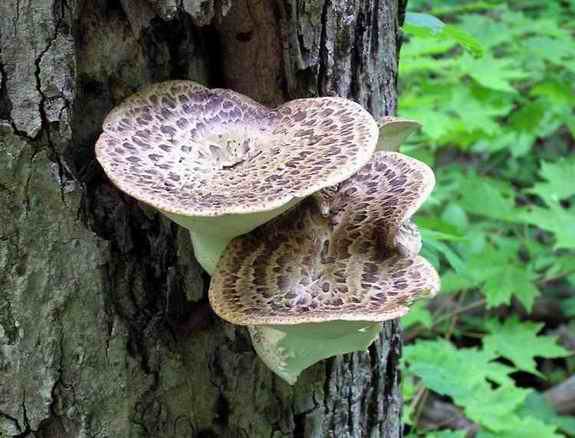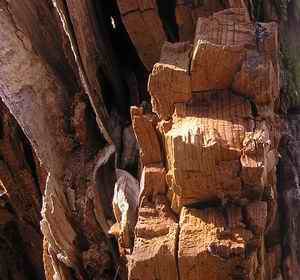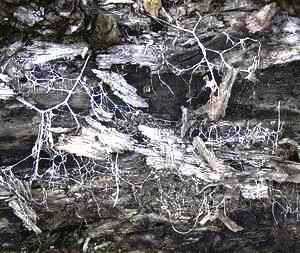|
Return to Hiker's Notebook Home Page
Common Name: Dryad's Saddle, Pheasant-back Polypore - In Greek mythology, dryads were forest nymphs who were responsible for the trees and did not mingle with the other gods. They were depicted with oak-leave crowns and carried axes to protect their charges from intruders. The Dryad's Saddle provided a flat pliable surface on the side of the tree, affording a protective vantage point, a saddle for a dryad. Pheasant-back is a more plebeian name that notes that the feather-like scales on the surface of the fungus look like the back of a pheasant.
Scientific Name: Polyporus squamosus - The generic name refers to the many pores on the underside of the fruiting body from which spores emanate. Squama is Latin for scale, the derivative species name describing the dark scales on the upper surface.
The Dryad's Saddle is one of the first fungi to appear in the spring which is probably the reason that it is classified as edible. Frustrated morel hunters, thwarted in search of their intended quarry, likely seized on it as an alternative, as it is quite conspicuous and readily identifiable even to novice mycophagists. It is palatable only if the cap margins of the very young fruitbody are harvested; the flavor has been compared to cucumbers. As it matures, it becomes tough and leathery, which may be another reason why it is called the Dryad's Saddle, because it tastes like one. They can grow to be quite large, measuring up to two feet across in extreme cases
The Dryad's Saddle is a polypore, which means that the underside of the cap is covered with pores. The pores serve the same function as the gills that are on the underside of the cap on most mushrooms; they contain structures called basidia that create, protect and eject the spores when the environmental conditions for propagation are present. The genus Polyporus is a subset of the vernacular term polypore for those fungi that have a stipe or stalk, have large, cylindrical spores, have a dimitic or trimitic hyphal system, and cause white rot.
When a fungal spore germinates, it sends out a thin filament called a hypha, which extends by forming sequential walls called septa along its length. If the hypha links up with other hypha of appropriate "gender," it will ultimately form the underground body of the fungus called the mycelium. A monomitic fungus has only hyphae that are generated by septae and is therefore soft to the touch, like chanterelles. Dimitic and trimitic fungi have thick-walled non-septate hyphae in addition to the septate hyphae, causing the hardened structure that is characteristic of polypores. Dryad's Saddle can be made into art paper because of its thick walled hyphal structure.
Polypores are very important for wood decay, and are classified as white rot
or brown rot fungi according to the primary part of the wood structure that is
consumed. All plant cell walls are made out of cellulose, which is white in
color. Woody plants add a second layer of cells inside the primary cellulose
cell walls that is called lignin, which is brown in color. Brown rot fungi
(right) consume the white cellulose and leave the brown lignin behind. White
rot fungi (below left) consume the brown lignin and leave the white cellulose
behind There are some fungi that are sometimes called "simultaneous wood
rotters" that consume the brown lignin first and then consume the white
cellulose. Since the brown lignin is consumed first, they initially appear to
be white rot fungi. Since brown rot removes the supporting cellulose, the
resultant depleted wood is
|


 soft
and crumbles easily. White rot fungi, on the other hand, leave the stringy
cellulose behind. The removal of brown lignin with noxious bleaches and other
chemicals is one of the main processes of the paper making industry. One of
the promising developments of mycology is to use white rot fungi to perform
the lignin removal process biologically with no deleterious byproducts. Lignin
is used in the manufacture of synthetic rubber tires, in the manufacture of
pigments and synthetic resins, as a tanning agent in the leather industry, and
as a source of vanillin, the active ingredient of vanilla.
soft
and crumbles easily. White rot fungi, on the other hand, leave the stringy
cellulose behind. The removal of brown lignin with noxious bleaches and other
chemicals is one of the main processes of the paper making industry. One of
the promising developments of mycology is to use white rot fungi to perform
the lignin removal process biologically with no deleterious byproducts. Lignin
is used in the manufacture of synthetic rubber tires, in the manufacture of
pigments and synthetic resins, as a tanning agent in the leather industry, and
as a source of vanillin, the active ingredient of vanilla.